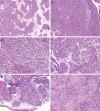Esthesioneuroblastoma, neuroendocrine carcinoma, and sinonasal undifferentiated carcinoma: differentiation in diagnosis and treatment
- PMID: 25992139
- PMCID: PMC4399581
- DOI: 10.1055/s-0034-1390014
Esthesioneuroblastoma, neuroendocrine carcinoma, and sinonasal undifferentiated carcinoma: differentiation in diagnosis and treatment
Abstract
Introduction Malignant sinonasal tumors comprise less than 1% of all neoplasms. A wide variety of tumors occurring primarily in this site can present with an undifferentiated or poorly differentiated morphology. Among them are esthesioneuroblastomas, sinonasal undifferentiated carcinomas, and neuroendocrine carcinomas. Objectives We will discuss diagnostic strategies, recent advances in immunohistochemistry and molecular diagnosis, and treatment strategies. Data Synthesis These lesions are diagnostically challenging, and up to 30% of sinonasal malignancies referred to the University of Texas MD Anderson Cancer Center are given a different diagnosis on review of pathology. Correct classification is vital, as these tumors are significantly different in biological behavior and response to treatment. The past decade has witnessed advances in diagnosis and therapeutic modalities leading to improvements in survival. However, the optimal treatment for esthesioneuroblastoma, sinonasal undifferentiated carcinoma, and neuroendocrine carcinoma remain debated. We discuss advances in immunohistochemistry and molecular diagnosis, diagnostic strategies, and treatment selection. Conclusions There are significant differences in prognosis and treatment for esthesioneuroblastoma, neuroendocrine carcinoma, and sinonasal undifferentiated carcinoma. Recent advances have the potential to improve oncologic outcomes but further investigation in needed.
Keywords: esthesioneuroblastoma; neuroendocrine carcinoma; olfactory neuroblastoma; sinonasal malignancy; sinonasal undifferentiated carcinoma.
Figures

References
-
- Faragalla H, Weinreb I. Olfactory neuroblastoma: a review and update. Adv Anat Pathol. 2009;16(5):322–331. - PubMed
-
- Ow T J, Bell D, Kupferman M E, Demonte F, Hanna E Y. Esthesioneuroblastoma. Neurosurg Clin N Am. 2013;24(1):51–65. - PubMed
-
- Holland H, Koschny R, Krupp W. et al.Comprehensive cytogenetic characterization of an esthesioneuroblastoma. Cancer Genet Cytogenet. 2007;173(2):89–96. - PubMed
Publication types
LinkOut - more resources
Full Text Sources
Other Literature Sources
Miscellaneous

